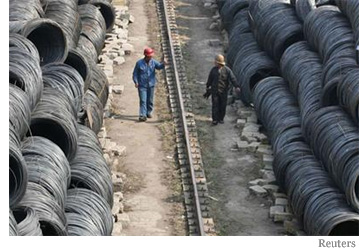China Knocks Rust off Northeast
 By Jennifer Wu
By Jennifer Wu
June 12 – Multi-colored snow art and illuminated ice sculptures greeted visitors from near and far at the Harbin Ice Festival. Held in the capital of Heilongjiang province, the annual festivities bring together everyone from ice sculpture artists and experts to fans and tourists alike. The snow and ice that draws so many tourists also helps to obscure the region’s industrial past, concealing what has become in recent years China’s largest rust belt. After years of neglect, the region is again seeing renewed government interest and incentives aimed at transforming this former industrial center into a viable economic region.
Once known as the cradle of industrialization in the 1950s, Northeast China saw its importance diminish as the country’s market-oriented reforms took hold in the late 1970s. In the last few years, the old industrial base has been on the rise again, as the government pours money and resources in. Today, the region, which consists of Heiongjiang, Jilin, and Liaoning provinces, is expected to transform into the China’s fourth economic engine, after the Pearl River Delta, the Yangtze River Delta, and the Beijing-Tianjin area.
In comparison to the other major economic powerhouse areas, the Northeast’s main weakness is an obsolete economic structure. But with Beijing’s unveiling of a grand plan last August to rejuvenate the region, the area has witnessed unprecedented development. The official action plan promotes the goal of fully revitalizing Northeast China’s industrial economies within the next 10 to 15 years.
Traditionally, Northeast China has been agriculturally productive in addition to being instrumental in the heavy industry and manufacturing sectors. Under the new plan, the region is to transform itself into a significant supplier of grain and farm produce, as well as a competitive manufacturing center and as a major provider of raw materials and energy.
More specifically, major firms there are expected to make advancements in the production of a variety of machinery and of equipment and in the development of high-tech industries. Furthermore, the plan encourages addressing logistical, infrastructure, and service concerns so as to revamp the entire economic framework, making the area more conducive to business set-up and employment.
As the cost of manufacturing in the Pearl River Delta increases, more and more multinational manufacturers are considering moving or setting up operations in other, less costly regions of China. The 2007 “Report on China’s National Economic and Social Development” showed that last year alone, investment from overseas in Northeast China increased over 70 percent. However, the region still has a long way to go. With the exception of Dalian, cities in the Northeast have attracted few major overseas companies. In addition, most foreign investment has been coming from South Korea and Japan, countries geographically closer to the region. Major American and European investors still seem to prefer the established regions of South and East China.
China’s efforts to revitalize Northeast China indeed have already begun to see encouraging results. Last year, Liaoning became the eighth province in the country, and the first in the northeast, to reach a GDP of over RMB1 trillion. Acting governor Chen Zhenggao cited the great growth in GDP as evidence of the province’s entry into a new phase of economic development. With the largest economy in the northeast, the province serves as one of China’s prime industrial bases and is known for supplying petroleum, natural resources such as iron and magnesite, machinery, corn, soybeans, and apples, among other commodities.
The province of Jilin also has large-scale aspirations to drive up its gross production value past the RMB1 trillion mark, reform and modernize its agricultural, industrial and environmental practices, as well as increase its return on investment. The farm produce processing, petrochemical and automobile industries in particular witnessed momentous expansion, contributing to record industrial net profits for Jilin. Its efforts to develop foreign trade have generated worldwide investor interest. The third Jilin and Northeast Asia Investment and Trade Expo last September speaks to the investment boom stemming from the area. A reported 700 plus projects were signed into contract and valued at approximately RMB200 billion.
Finally, as one of the country’s principal forestry regions, Heilongjiang is a chief lumber provider. Additionally, the area is a major supplier of rice, contributing 25 percent of the China’s commercial rice output in 2007. Heilongjiang is also recognized as a leading industrial hub, producing heavy machinery and notably, nearly half of the nation’s oil. In late March of this year, the new pontoon bridge linking the city of Tongjiang in Heilongjiang and the city of Nizhneleninskoye in Russia opened, providing a solution to the ice that had impeded winter trade and allowing for year-round operations of cargo transportation between China and Russia.
The Harbin Ice Festival in Heilongjiang attracts tourists eager to see the beauty of Northeast China, Beijing has invested time and money to make the region equally as attractive to investors. The government is betting that its policy incentives will help the region realize unprecedented levels of investment in the years to come. If that should happen, the rust belt that is Northeast China may yet shine again.
- Previous Article A City Off Balance, Beijing Moves West of Tiananmen
- Next Article FDI in China Increases 50 Percent









